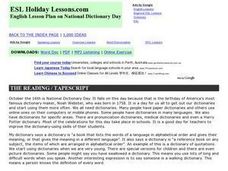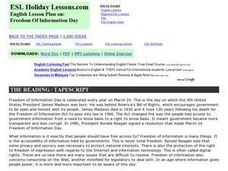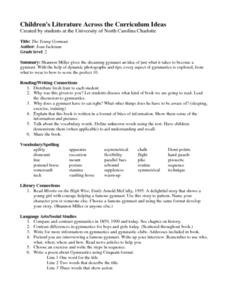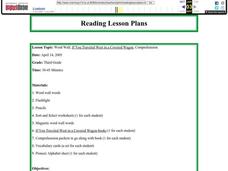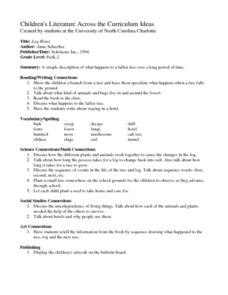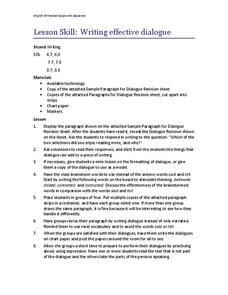Curated OER
National Dictionary Day
In this National Dictionary Day worksheet, students complete activities including reading a passage, matching phrases, fill in the blanks, correct word choosing, multiple choice, sequencing, unscramble the sentences, write questions,...
Curated OER
Freedom of Information Day
In this Freedom of Information Day worksheet, students complete activities such as reading a passage, phrase matching, fill in the blanks, correct words, multiple choice, spelling sequencing, scrambled sentences, asking questions,...
Curated OER
Beginning and Ending Sounds
First graders practice the beginning and ending sounds of words. In this phonological awareness lesson, 1st graders use picture cards for one syllable words and pronounce each word. Students match other picture cards with the same...
Curated OER
Alphabet Activity Worksheets
For this alphabet activity worksheet, students respond to questions that require them to print the letters A-Z, print words that begin with those letters, respond to alphabetical order questions, and locate the letters in letter search...
Curated OER
Practice Exam Part 1: Vocabulary
In this geometry worksheet, students practice constructing a variety of graphs with various degrees of vertices. Students determine whether 12 graphs have an Euler circuit or path.
Curated OER
Tense Buster
Pupils, after using the "Intermediate" selection of the Tense Buster software, recognize and practice using passive voice in their writing. As a result of this task, they correctly use five new vocabulary terms with passive voice in...
Curated OER
The Young Gymnast
Second graders compare and contrast gymnastics in 1859, 1900 and today. Students contrast differences in gymnastics for boys and girls today. Students pretend that they are interviewing a famous gymnast and write up their interview....
Curated OER
Class Tales
Students improve their reading comprehension by role-playing a bear hunt story. In this reading comprehension lesson, students pretend to go on a bear hunt and complete an art project for the story.
Curated OER
Word Wall, If You Traveled West in a Covered Wagon
Third graders use vocabulary from "If You Traveled West in a Covered Wagon" to play a game.
Curated OER
A Content Lesson Througha Communicative Sequence
Students see pictures, and are asked to respond to them. The teacher focuses on pointing out new vocabulary that may be embedded in the picture. They relate another person's journey to themelves.
Curated OER
Writing Algebraic Expressions for Words
Students explore the concept of algebraic expressions. In this algebraic expressions lesson, students convert pictures and word problems into algebraic expressions. Students play a game where they tell the algebraic expression...
Curated OER
Guided Reading -- If You Give a Mouse a Cookie
Students are read the book "If You Give a Mouse a Cookie" page by page and discuss their favorite types of cookies. They predict what they believe will happen next based on what has already happened in the story. They practice putting...
Curated OER
Inca Culture and Society
Students read parts of text about Inca culture and society, put the text in the correct order, and discuss how they feel about the text. In this Inca lesson plan, students match Inca vocabulary to definitions.
Curated OER
The Big Sneeze
Young scholars participate in a variety of shared reading and writing activities related to the book "The Big Sneeze" by Ruth Brown. They develop a list of farm vocabulary, sequence the events of the story on a graphic organizer, act out...
Curated OER
Synonym Scramble
Play a game with a deck of cards to reinforce synonyms and vocabulary. Young spellers look at the blue words on the cards they are holding and try to match it with the red word the teacher is holding. The game continues until the deck is...
Curated OER
Log Hotel
Students identify how the different plants and animals work together to cause the changes in the log. Students discuss the sequence of events in the life of the tree and log. Students plant a seed to take home and care for. Students...
Curated OER
Estimating Solutions
Finding approximate solutions to word problems allows users to assess the reasonableness of their answers. In a well-paced lesson, the class rounds numbers to estimate the solutions. They explain their thinking and determine if the...
Curated OER
A Walk Around the School: Mapping Places Near and Far
After reading Pat Hutchins’ Rosie’s Walk, have your young cartographers create a map of Rosie’s walk. Then lead them on a walk around the school. When you return class members sequence the walk by making a list of how the class got from...
Curated OER
Direct, Inverse, And Joint Variation
Young scholars engage in a lesson that has them practice solving equations using multiplication and division. They practice solving problems using the properties needed and then students practice changing word problems into an equation.
Virginia Department of Education
Writing Effective Dialogue
Spend a productive hour in the classroom with this tutorial where junior high writers discover how to create snappy dialogue. The learning begins with an analysis of sample writing and discussion on the effectiveness of each piece. The...
Curated OER
Alphabet Sideshow
Learners practice sound and recognition of letters in alphabetical sequence. They gain an understanding of letter sounds and order. They create a slide show with graphics and text. They present their slide show to the class.
Curated OER
Recounts: Writing a Summary
Have your class review how to summarize a story. Learners discuss the way to write a summary and talk about the use of sequence words. The presentation uses a graphic organizer. This helps to make it a visually appealing presentation.
Curated OER
Lord of the Flies - Sentence Starters and Vocabulary
Students prepare for the reading of iam Golding's novel, The Lord of the Flies, by exploring the theme through a discussion and sentence starter activity.
Curated OER
Scatter Cat!
First graders read the story Hairy MacLary, Scatter Cat by Lynley Dodd, to provide a context in which to use the language of movement and position and to provide opportunities to move themselves as they act out parts of the story.
